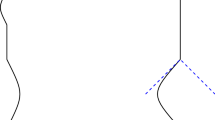Abstract
In non-relativistic Bohmian mechanics the universe is represented by a probability space whose sample space is composed of the Bohmian trajectories. In relativistic Bohmian mechanics an entire class of empirically equivalent probability spaces can be defined, one for every foliation of spacetime. In the literature the hypothesis has been advanced that a single preferred foliation is allowed, and that this foliation derives from the universal wave function by means of a covariant law. In the present paper the opposite hypothesis is advanced, i.e., no law exists for the foliations and therefore all the foliations are allowed. The resulting model of the universe is basically the “union” of all the probability spaces associated with the foliations. This hypothesis is mainly motivated by the fact that any law defining a preferred foliation is empirically irrelevant. It is also argued that the absence of a preferred foliation may reduce the well known conflict between Bohmian mechanics and relativity.
Similar content being viewed by others
Notes
In the relativistic formulation the symbols \(\mathbb {K}\) and \(\mathbb {B}\) are redefined.
Here a world line is considered to be a subset of M, and its intersection with any hypersurface is exactly one point.
This point can be better understood by means of the following analogy: in non-relativistic Bohmian mechanics the set \(\mathbb {B}\) defined in Sect. 2 is the set of the trajectories which are dynamically allowed by the guiding equation. If the guiding equation is removed as a law, the set of the allowed trajectories becomes the entire kinematic space \(\mathbb {K}\).
References
Allori, V., Goldstein, S., Tumulka, R., Zanghì, N.: On the common structure of Bohmian mechanics and the Ghirardi–Rimini–Weber theory. Brit. J. Philos. Sci. 59, 353–389 (2008). arXiv:quant-ph/0603027
Berndl, K., Dürr, D., Goldstein, S., Zanghì, N.: Nonlocality, Lorentz invariance, and Bohmian quantum theory. Phys. Rev. A 53, 2062–2073 (1996). arXiv:quant-ph/9510027
Bohm, D., Hiley, B.J.: The Undivided Universe. Routledge, New York (1993)
Dürr, D., Goldstein, S., Münch-Berndl, K., Zanghì, N.: Hypersurface Bohm–Dirac models. Phys. Rev. A 60, 2729–2736 (1999). arXiv:quant-ph/9801070
Dürr, D., Goldstein, S., Norsen, T., Struyve, W., Zanghì, N.: Can Bohmian mechanics be made relativistic? Proc. Roy. Soc. A 470, 20130699 (2013). arXiv:1307.1714
Dürr, D., Goldstein, S., Zanghì, N.: Quantum Physics Without Quantum Philosophy. Springer, Berlin (2013)
Dürr, D., Goldstein, S., Zanghì, N.: Quantum equilibrium and the origin of absolute uncertainty. J. Statist. Phys. 67, 843-907 (1992). arXiv:quant-ph/0308039
Dürr, D., Teufel, S.: Bohmian Mechanics. Springer, Berlin (2009)
Galvan, B.: Generalization of the Born rule. Phys. Rev. A 78, 042113 (2008). arXiv:0806.4935
Goldstein, S.: Boltzmann’s approach to statistical mechanics. In: Bricmont, J., Dürr, D., Galavotti, M. C., Ghirardi, G., Petruccione, F., Zanghí, N. (eds.): Chance in Physics: Foundations and Perspectives, pp. 39–54. Lecture notes in Physics 574. Springer Berlin (2001). arXiv:cond-mat/0105242
Goldstein, S.: Typicality and notions of probability in physics. In: Ben-Menahem, Y., Hemmo, M. (eds.) Probability in Physics, pp. 59–71. Springer, Berlin (2012)
Holland, P.R.: The Quantum Theory of Motion. Cambridge University Press, Cambridge (1993)
Huber, P.J.: Robust Statistics. Wiley, New York (1981)
Maudlin, T.: Space-Time in the Quantum World. In: Cushing, J.T., Fine, A., Goldstein, S. (eds.) Bohmian Mechanics and Quantum Theory: An Appraisal. Kluwer Academic, Dordrecht (1996)
Shafer, G.: From Cournots principle to market efficiency. In: Touffut, J. P. (ed.) Augustin Cournot: Modelling Economics. Edward Elgar (2007) http://www.glennshafer.com
Author information
Authors and Affiliations
Corresponding author
Rights and permissions
About this article
Cite this article
Galvan, B. Relativistic Bohmian Mechanics Without a Preferred Foliation. J Stat Phys 161, 1268–1275 (2015). https://doi.org/10.1007/s10955-015-1369-8
Received:
Accepted:
Published:
Issue Date:
DOI: https://doi.org/10.1007/s10955-015-1369-8




